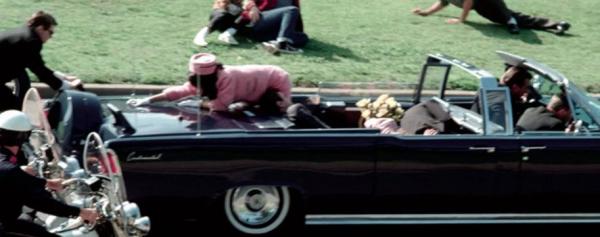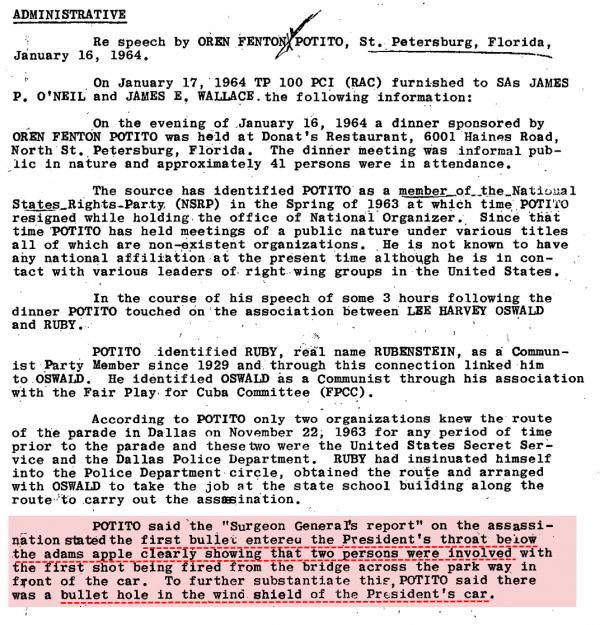The released files clearly acknowledge government conspiracy and cover-up in the Kennedy assassination. As if anyone is surprised – when the official explanation needs a magic bullet to have zig-zagged around; when Oswald, the alleged lone assassin is conveniently assassinated himself, when the presidential motorcade was conveniently denied any live TV coverage, with the media told to wait for a speech at the end of the motorcade…
Will there be any public outcry, or will the sheeple quietly ignore it, and send the message to the CIA and other organizations that the people will tolerate that they can do whatever they want. What message does it send to Trump, if they can kill a president they don’t like, and get away with it?

As written up in an article at Zerohedge.com:
“…the “Surgeon General’s Report” on the assassination stated that the first bullet entered the President’s throat below the adams apple, clearly showing that two persons were involved with the first shot being fired from the bridge across the park way in front of the car.
To further substantiate this, POTITO said there was a bullet hole in the wind shield of the President’s car…
Not exactly the narrative that was sold to the world – and certainly not the narrative that J. Edgar Hoover proclaimed must be defended to the world.
Here is Douglas P. Horne, via LewRockwell.com, detailing the photographic evidence of a bullet hole in JFK’s limousine’s windshield “hiding in plain sight.”
In 2009, I believed I had discovered new evidence in the JFK assassination never reported by anyone else: convincing photography of the through-and-through bullet hole in the windshield of the JFK limousine that had been reported by six credible witnesses. I revisited that evidence today, and am more convinced than ever that the bullet hole in the limousine windshield is what I am looking at in those images. But the readers of this piece don’t have to take my word for it — you can examine the images yourself, and make up your own minds. The evidence is contained in one of the banned, suppressed episodes of Nigel Turner’s The Men Who Killed Kennedy — episode 7 in the series, called “The Smoking Guns,” which was aired in 2003, and then removed from circulation by The History Channel in response to intense political pressure by former LBJ aides Jack Valenti and Bill Moyers.
I’ll tell you about the stunning evidence I have found in that episode at the end of this article, but first we need to set the stage by reviewing the eyewitness testimony about the damage to the windshield observed the day of JFK’s assassination, on Friday, November 22nd, 1963; as well as three days later, on Monday, November 25th, 1963.
Introduction
Before I reveal the details about the “new” photographic evidence I am talking about here, let’s review the Big Picture, the “evidentiary landscape” on this issue (see pages 1439-1450 of Volume V of my book, Inside the Assassination Records Review Board, for full details):
(1) Dallas motorcycle patrolmen Stavis Ellis and H. R. Freeman both observed a penetrating bullet hole in the limousine windshield at Parkland Hospital. Ellis told interviewer Gil Toff in 1971: “There was a hole in the left front windshield…You could put a pencil through it…you could take a regular standard writing pencil…and stick [it] through there.” Freeman corroborated this, saying: “[I was] right beside it. I could of [sic] touched it…it was a bullet hole. You could tell what it was.” [David Lifton published these quotations in his 1980 book, Best Evidence.]
(2) St. Louis Post-Dispatch reporter Richard Dudman wrote an article published in The New Republic on December 21, 1963, in which he stated: “A few of us noted the hole in the windshield when the limousine was standing at the emergency entrance after the President had been carried inside. I could not approach close enough to see which side was the cup-shaped spot which indicates a bullet had pierced the glass from the opposite side.”
(3) Second year medical student Evalea Glanges, enrolled at Southwestern Medical University in Dallas, right next door to Parkland Hospital, told attorney Doug Weldon in 1999: “It was a real clean hole.” In a videotaped interview aired in the suppressed episode 7 of Nigel Turner’s The Men Who Killed Kennedy, titled “The Smoking Guns,” she said: “…it was very clear, it was a through-and-through bullet hole through the windshield of the car, from the front to the back…it seemed like a high-velocity bullet that had penetrated from front-to-back in that glass pane.” At the time of the interview, Glanges had risen to the position of Chairperson of the Department of Surgery, at John Peter Smith Hospital, in Fort Worth. She had been a firearms expert all her adult life.
(4) Mr. George Whitaker, Sr., a senior manager at the Ford Motor Company’s Rouge Plant in Detroit, Michigan, told attorney (and professor of criminal justice) Doug Weldon in August of 1993, in a tape recorded conversation, that after reporting to work on Monday, November 25th, he discovered the JFK limousine — a unique, one-of-a-kind item that he unequivocally identified — in the Rouge Plant’s B building, with the interior stripped out and in the process of being replaced, and with the windshield removed. He was then contacted by one of the Vice Presidents of the division for which he worked, and directed to report to the glass plant lab, immediately. After knocking on the locked door (which he found most unusual), he was let in by two of his subordinates and discovered that they were in possession of the windshield that had been removed from the JFK limousine. They had been told to use it as a template, and to make a new windshield identical to it in shape — and to then get the new windshield back to the B building for installation in the Presidential limousine that was quickly being rebuilt. Whitaker told Weldon (quoting from the audiotape of the 1993 interview): “And the windshield had a bullet hole in it, coming from the outside through…it was a good, clean bullet hole, right straight through, from the front. And you can tell, when the bullet hits the windshield, like when you hit a rock or something, what happens? The back chips out and the front may just have a pinhole in it…this had a clean round hole in the front and fragmentation coming out the back.” Whitaker told Weldon that he eventually became superintendent of his division and was placed in charge of five plant divisions. He also told Weldon that the original windshield, with the bullet hole in it, had been broken up and scrapped — as ordered — after the new windshield had been made.
When Doug Weldon interviewed Whitaker in August of 1993, his witness insisted on anonymity. Weldon reported on the story without releasing Whitaker’s name in his excellent and comprehensive article titled: “The Kennedy Limousine: Dallas 1963,” which was published in Jim Fetzer’s anthology Murder in Dealey Plaza, in 2000. After Weldon interviewed Whitaker in August of 1993, Mr. Whitaker subsequently — on November 22, 1993 (the 30th anniversary of President Kennedy’s assassination) — wrote down all he could remember about the events he witnessed involving the Presidential limousine and its windshield. After George Whitaker’s death in 2001, his family released his written testament to Nigel Turner, who with their permission revealed Mr. Whitaker’s name, as well as the text of his “memo for history,” in episode 7 of The Men Who Killed Kennedy, “The Smoking Guns.”
In “The Smoking Guns,” the text of Whitaker’s memo can be read on the screen employing freeze frame technology with the DVD of the episode. It said, in part: “When [I] arrived at the lab the door was locked. I was let in. There were 2 glass engineers there. They had a car windshield that had a bullet hole in it. The hole was about 4 or 6 inches to the right of the rear view mirror [as viewed from the front]. The impact had come from the front of the windshield. (If you have spent 40 years in the glass [illegible] you know which way the impack [sic] was from.”
(5) The sixth credible witness to a bullet hole in the windshield of the limousine was Secret Service agent Charles Taylor, Jr., who wrote a report on November 27, 1963 in which he detailed his activities providing security for the limousine immediately after the car’s return to Washington following the assassination. The JFK limousine and the Secret Service follow-up car known as the “Queen Mary” arrived at Andrews AFB aboard a C-130 propeller-driven cargo plane at about 8:00 PM on November 22, 1963. Agent Taylor rode in the Presidential limousine as it was driven from Andrews AFB to the White House garage at 22nd and M Streets, N.W. In his report about what he witnessed inside the White House garage during the vehicle’s inspection, he wrote: “In addition, of particular note was the small hole just left of center in the windshield from which what appeared to be bullet fragments were removed.”
Summary of the Eyewitness Testimony About the Windshield Bullet Hole
Summarizing, six credible witnesses — Stavis Ellis, H. R. Freeman, Richard Dudman, Evalea Glanges, George Whitaker, and Charles Taylor — all reported seeing a bullet hole in the windshield of JFK’s limousine either on the day of the assassination (for five of the six witnesses), or on the following Monday (in the case of Mr. Whitaker, who did not see the limousine and its windshield until he reported to work at the Ford Motor Company’s Rouge Plant, in Detroit, on Monday morning, November 25th, 1963).
Two of these witnesses — Evalea Glanges and George Whitaker — were absolutely positive that the bullet causing the damage had been a shot from the front, which had entered the front surface of the windshield, and exited the inside surface.
WHY IS THIS IMPORTANT? Because if true, the windshield bullet evidence alone disproves the lone assassin myth aggressively promoted by the U.S. government for 49 years now, since the accused assassin, Lee Harvey Oswald, was supposedly firing from above and behind the limousine as it traveled down Elm Street.
The Windshield Evidence Was Twice Switched-Out — Substituted — By the U.S. Government…
The windshield in evidence today at the National Archives is not the windshield that was in the Presidential limousine on Elm Street, in Dallas, on November 22, 1963. It simply cannot be. Why? Remember, according to George Whitaker, Sr. of the Ford Motor Co., the original was destroyed, per company orders, after it was used as a template to make a replacement on November 25th, 1963…”

